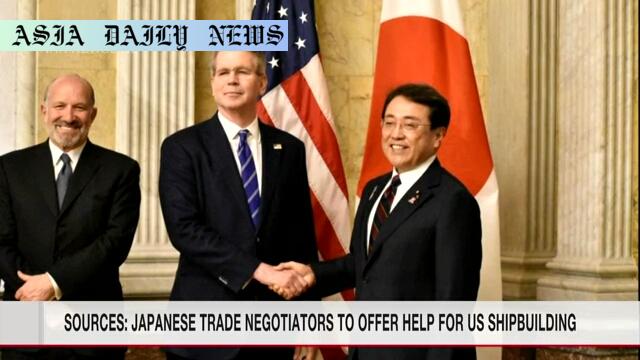Shipbuilding: Japan offers key support to revive US shipbuilding industry and strengthen its supply chain capabilities.
- Key Point 1: Japan is offering significant aid to support US shipbuilding and repair capabilities.
- Key Point 2: Strengthening supply chains and ice-breaking vessel development are prioritized in the proposal.
- Key Point 3: The shipbuilding proposal aims to bolster bilateral trade agreements during upcoming talks.
- Key Point 4: Japan continues to lobby for the removal of US tariffs on Japanese cars.
- Key Point 5: Increased automotive-related investments in America are part of Japan’s strategy.

Japan’s Strategic Proposal to Revive US Shipbuilding
Japan has presented itself as a key ally in revitalizing the United States’ shipbuilding industry. The proposal, offered by Japanese trade negotiators, seeks to enhance repair capabilities and fortify the supply chain within America’s maritime sector. This initiative is set to be a priority agenda in the upcoming bilateral trade talks, potentially in mid-May, signaling Japan’s commitment to strengthening its economic partnership with the US.
The collaboration not only tackles critical aspects of shipbuilding but also includes the development of Arctic-capable ice-breaking vessels. These specialized ships are instrumental for navigating harsh polar conditions, a notable move considering the increasing importance of Arctic trade routes. By extending such cutting-edge support, Japan aims to showcase its technological prowess and alignment with global maritime sustainability objectives.
Reinforcing Bilateral Trade Through Shipbuilding
Beyond the shipbuilding directive, both nations are exploring broader economic terms. Japan has been assertively advocating for increased automotive-related investments in the US. This approach reflects Tokyo’s intention to mitigate the Trump-era tariffs on Japanese cars and secure more favorable trade terms. A recurring demand from Japanese Prime Minister Ishiba Shigeru is for a complete removal of these levies, underscoring their economic impact on Japan’s automotive and manufacturing industries.
By investing in American manufacturing, Japan hopes to create a win-win scenario where both economies flourish collaboratively. The interplay between strategic investments in shipbuilding and bolstering the automotive sector is a critical component of the Japanese economic revitalization strategy, led by Economic Minister Akazawa Ryosei.
The Broader Implications of Japan’s Shipbuilding Offer
The decision to prioritize US shipbuilding exemplifies Japan’s approach to fostering mutual economic benefits. Helping develop and strengthen the supply chain goes beyond just infrastructure; it promotes job creation and improves competitiveness in both nations. This gesture also aligns with Japan’s broader diplomatic goal of fostering a stronger trans-Pacific alliance.
Additionally, with Arctic ice-breaking vessels in focus, Japan is positioning itself as a leader in specialized naval technologies. This move not only aids the US but also contributes to global maritime safety and sustainability, crucial for navigating the increasingly accessible—and geopolitically contested—Arctic Circle.
As these initiatives gain momentum, they signify a pivotal chapter in Japan-US relations. By leveraging its experience and resources in shipbuilding, Japan is fostering a relationship of shared innovation and economic empowerment.



Commentary
Proactive Maritime Collaboration
Japan’s decision to actively assist in revitalizing the US shipbuilding industry is both a strategic and commendable move. It reflects a commitment to fostering mutually beneficial trade partnerships, emphasizing how economic collaboration can spark growth for both parties. This particular gesture is not merely about economic gain—it underscores Japan’s position as a reliable ally with a vested interest in US progress.
Enhancing Competitiveness in Shipbuilding
By focusing on repairing capabilities and supply chain improvement, Japan is addressing areas that could have long-term implications for the global shipbuilding industry. Modernizing supply chains ensures that shipbuilding efforts are efficient, cost-effective, and suited to international demand. This response to challenges faced by US shipbuilders is strategic, showing Japan’s willingness to tackle existing inefficiencies through collaboration.
A Strategic Approach to Tariff Concerns
Japan’s inclusion of automotive-related investments in its trade negotiations is a crucial aspect of their broader strategy. The Trump administration’s tariffs on Japanese cars have been a contentious issue, and Japan’s proactive stance in addressing this roadblock reflects its pragmatic diplomacy. By linking investments in US manufacturing to trade negotiations, Japan strengthens its argument for tariff removal while benefiting American industry.
This business-forward yet diplomatic approach indicates a calculated effort by Japan to align its economic goals with shared interests—solidifying trust while ensuring mutual benefit. Both nations stand to benefit from these efforts, making this a promising chapter for bilateral relations.